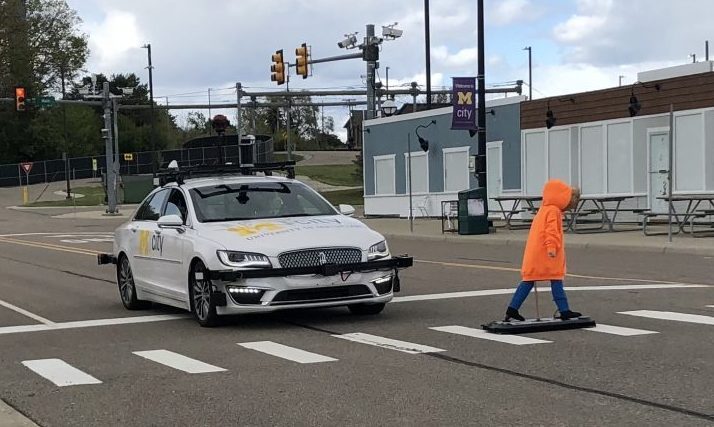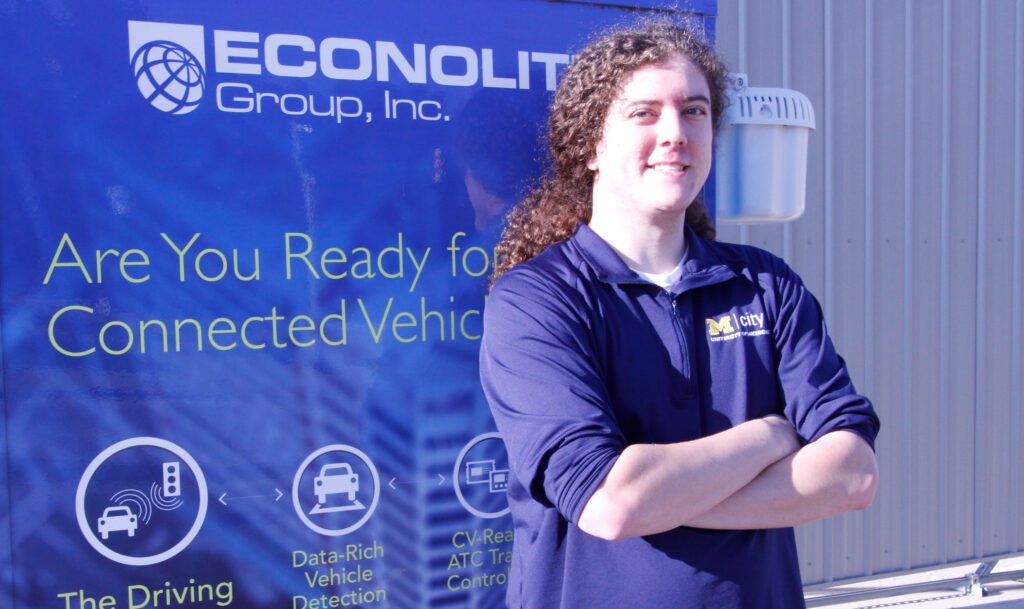Research engineer curious about car turn signals as a child now troubleshoots traffic tech at Mcity Test Facility

The first time future research engineer Vince Belanger encountered a connected vehicle, he was five years old. The year was 2003 and Vince wasn’t a research engineer yet, of course, but that was OK because the car wasn’t really a connected vehicle.
“Being a kid at five years old, I didn’t understand turn signals; I thought they came on when the car turned,” he recalls. “I thought, ‘How does the turn signal know when to turn on?’ I just figured the vehicle knew where we were going.”
Today, Vince, 26, is an Mcity research engineer, cars are increasingly connected, and he deals with many, many types of signals that control much more than indicating a simple turn.
Vince arrived at Mcity, a public-private mobility research center led by the University of Michigan, in May 2021. Mcity funds academic research, and has worked with its partners to launch advanced mobility pilot projects in Ann Arbor, Detroit and beyond. But the center may be best known for operating the Mcity Test Facility, a purpose-built proving ground for connected and automated vehicles and technologies that opened in 2015. The track replicates a real-world driving environment for safe, controlled, repeatable testing before moving to public roads.

Any one of the different devices that we have at the facility, whether it’s a camera, a data sensor, a traffic signal controller, if it breaks, I’m the one who fixes it. I wear a lot of hats.”
Vince Belanger, Research Engineer, Mcity
Vince’s work helps keep the test facility up and running even as new features and capabilities are added. He has handled networking issues, programming and software development, maintaining the computing capabilities of the test track’s small fleet of research vehicles, rolling out a major upgrade to the facility’s capabilities and more. One recent challenge was updating the software used to remotely open and close the doors of a multi-bay garage located on the entry road to the test track. The original programming had reverse-engineered an existing application as part of the process, but once that application was updated, it was no longer compatible with the test-track system.
“Any of the different devices that we have at the facility, whether it’s a camera, a data sensor, a traffic signal controller, if it breaks, I’m the one who checks it out,” Vince says. “I wear a lot of hats.”
The rapid pace of development and change with autonomous vehicles means that Vince’s job has evolved, even in the few years he’s been on staff at Mcity.
“It started off as a network engineering job, with a lot of tasks related to sensors, infrastructure for autonomous vehicles, and just getting things connected and talking to each other,” Vince says. “It almost seemed a little too simple at first and then, as I dug into the intricacies of things, there were a lot of complicated little problems popping up. Then, with my software background, I started to pick up some of the software development projects. It was mostly small things at first but it became more than half of what I do. Pure network maintenance tasks are not that much of my job now.”
The list of projects he’s working on includes infrastructure improvements that will increase the functionality of Mcity OS, the cloud-based operating system introduced in early 2021. Mcity OS runs on any internet-enabled device, including vehicle computer platforms, laptops, tablets, and smartphones to control all the features of the Mcity Test Facility, including how test vehicles interact with intersections, train crossings, crosswalks, and other test facility features.
The upgrade to Mcity OS is the foundation of what Mcity is calling Mcity 2.0, the next-generation autonomous vehicle test facility. With $5.1 million in funding from the National Science Foundation, Mcity is building digital infrastructure that overlays the physical infrastructure of the Mcity Test Facility to enable remote use of the track by academic researchers nationwide. Mcity 2.0 users will need to offload data at high speeds to run vehicle tests remotely, and Mcity wants to make the track’s network up to 10 times faster.
“The network is how we get data from the vehicle to the user, or input commands to control the vehicle,” Vince explains. “With Mcity 2.0, researchers can remotely run their tests, but there are many challenges that must be addressed to make the technology work efficiently.”
It’s a far cry from the more mundane work Vince handled before coming to Mcity, when he served as a network administrator for a commercial real estate company after graduating from Brother Rice High School in Bloomfield Hills, Michigan, and earning a degree in computer science from the University of Dayton in Ohio.
Born in Troy, Michigan, Vince’s mother is a former English teacher now working as a freelance writer and copy editor, while his father, who holds a degree in aerospace engineering from the University of Michigan, teaches and consults. His younger brother, Paul, is studying philosophy and theology.
Vince lives in Northville, Michigan with his cat, May, where his personal life is nearly as busy as his job.
“I have too many hobbies,” he admits. It’s not a surprise that he runs servers in a home lab for the online games he plays with friends, reads up on quantum entanglement for pleasure, and lately has been experimenting with 3D printing to create masks of characters from movies and video games. Another big interest is music, whether writing songs for the guitar or making electronic music. “I was in bands in high school but I’ve always done solo stuff,” Vince says. “I enjoy playing but it’s more about the writing for me, and playing music is a vessel for that.”
He’s not surprised to find other musicians among his colleagues in engineering, technology and science.
“I was talking to some coworkers about how, with everyone we interview for jobs and internships, it’s never a surprise to see that they’re in a band or that they play an instrument. That almost goes hand-in-hand with this kind of work.”
Today, 20 years after he first wondered how cars could know where they were going and when to activate their turn signals, Vince’s imagination as a five-year-old has been vindicated.
“The route-planning system in our autonomous vehicles does exactly that,” Vince says. “I’ve already seen it happen.”
This story was written by Brian O’Connor, a Michigan-based freelance writer.